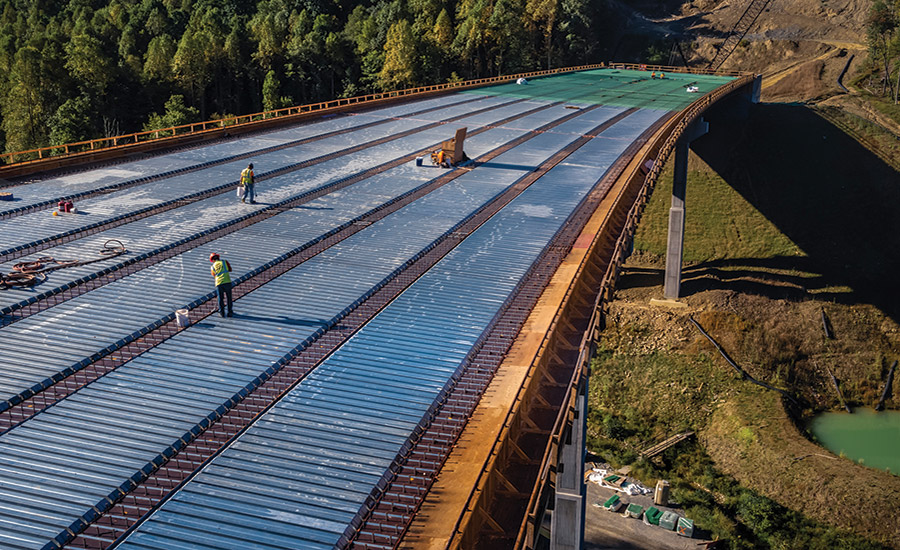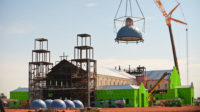Owners frequently call in professional services firms to streamline projects to completion and keep a pulse on the market. Lately, firms agree, that pulse is racing. Projects shelved last year are quickly rebooting while newer, more complex construction programs fill pipelines, driving many owners to seek support beyond their usual teams to manage the volume.
No firm can predict the future, but professional services firms can help owners figure out what might come next. “As we recover from the pandemic, there’s an unspoken understanding that our industry is anticipating an unprecedented volume of infrastructure work ahead,” says Steve Fleck, Stantec executive vice president and chief practice and project officer. Anticipation only adds fuel to an already fiery market, Fleck says, and that is also a major plot point behind 2021 Top 100 Professional Services Firms rankings.
|
Related Links |
Although the aggregate construction management and program management revenue from the Top 100 was down 5.8% overall in 2020 compared to 2019, median firm revenue was up 14.05% to $43.6 million, from $38.05 million—which signals that volume is growing among ranked firms of all sizes. Going into the 2021-22 post-pandemic cycles, firms anticipate projects of all sizes vying for scarce market resources.
“The influx of current and upcoming work is creating a war on talent to attract experienced project management leaders,” Fleck says, and firms are racing to grab the top talent they need to meet the demands of clients. Many of those needs have transformed over the course of the pandemic.
Different Business Than Usual
With early pandemic chaos still fresh in mind, more owners want operations resilience and help packaging their projects into well-planned, coherent programs, explains Michael B. Smith, Americas president of Hill International. It is a different approach from the usual siloed project system.
“Clients, especially in the public infrastructure sectors where Hill is particularly strong, are recovering quickly from the pandemic and in some cases are accelerating their project plans to make up for lost time,” says Smith. But beyond timelines, clients aren’t after a quick fix, he says. “We find that owners are demanding a more comprehensive assessment of how their program investments provide long-term value to their organizations,” Smith explains. That includes support to understand how “future disruptions can be anticipated, minimized and/or mitigated,” he adds.
Last year, domestically, Top 100 services firm revenue fell 9.9% while international revenue rose 8% (see chart, p. 46). Homing in on those percentages, the major difference in revenue appears in the top five rankings, which decreased by 15%— a more than $2.4 billion drop. All firms ranked in last year’s top 10 filed this year, so the decreased revenue could be the result of firms being more selective or sector slowdowns during the pandemic.
Ranking data shows there are seven firms new to the Top 100 list and to ENR survey rankings, including Galaxy Builders Ltd., Industrial Project Innovation LLC (IPI), Horne LLP, Hudson Meridian Construction Group, Ardmore Roderick, Entech Engineering Inc. and RGM Kramer Inc. Among those firms, many reported that their performance over the last few years is a deciding factor in filing this year.
“The ability to continue business despite adverse conditions is now a standard program management offering and is getting much more attention today than pre-COVID-19,” says Smith about the changing market for services firms. “We see clients adding a PgM, PM or CM function to their teams. This is true of all delivery methods, including design-build, progressive design-build, construction management-at-risk and integrated project delivery, as well as more vanilla types of contracts.”
To navigate pandemic-induced supply chain issues and a tight labor market, owners don’t want business as usual from services firms, Smith says—they seek deft project delivery and depth of knowledge. “Whether it’s identifying opportunities for cost savings during design or possible ways to accelerate a construction schedule, having an unbiased [subject matter expert] perspective on the team just makes sense when delivering a project of any complexity or scale,” he says.
Risks and Rewards
Although the worst of the COVID-19 pandemic seems to be in the rearview mirror, owners recognize that markets are still reeling from residual effects. As a result, there is heightened sensitivity around cost certainty and risk control, says John Robbins, managing director for the USA at Turner & Townsend.
“One of the biggest priority shifts has been toward risk assessment. This global event completely reframed how our clients think about cost certainty, contract and commercial agreements, supply chains and business continuity,” says Robbins.
“Many clients are asking us how best to set up processes and assurance to manage capital programs through life-changing events like COVID-19,” he adds. “We are helping clients look at contingency plans and how to set up systems in more resilient ways to manage through similar situations.”
The hope is that early precautions will reward owners in the long-term and decrease risk, Robbins points out. “Many, if not most, businesses have had a very tough fiscal year negotiating through the pandemic and keeping their capital projects afloat,” he says. “Added to that are the significant supply chain disruptions and fluctuations in construction materials, such as wood, steel and concrete products, as well as commodity prices.”
A positive result, EnTech Engineering reports, is that clients are more open to the flexibility that new technology provides, such as virtual meetings, jobsite inspections and 3D design collaboration. “Project owners have always placed a heavy emphasis on efficient project delivery, but the pandemic has caused an even greater focus on schedule and budget,” says Sue Bayat, founder and president of EnTech. “This has helped accelerate the adoption of advanced technologies, like BIM, as owners look for smarter solutions that help deliver projects faster and more economically.”
How well professional services firms can help owners maneuver through market conditions and avoid risk will be a major determinant of success next year, says Christopher Payne, president and CEO of McDonough Bolyard Peck Inc.
“At a high level, our clients are really not as confident in what they’re trying to build, given the changes we’ve seen,” he says. “We’re seeing more curiosity from clients about prefabricated and off-site assembly to help control schedule and reduce the risk of on-site construction.”
Payne adds that “as a services provider, we’re adapting our thinking to how we can extend our expertise across the whole supply chain.”
Additional reporting by Jonathan Keller.







Post a comment to this article
Report Abusive Comment